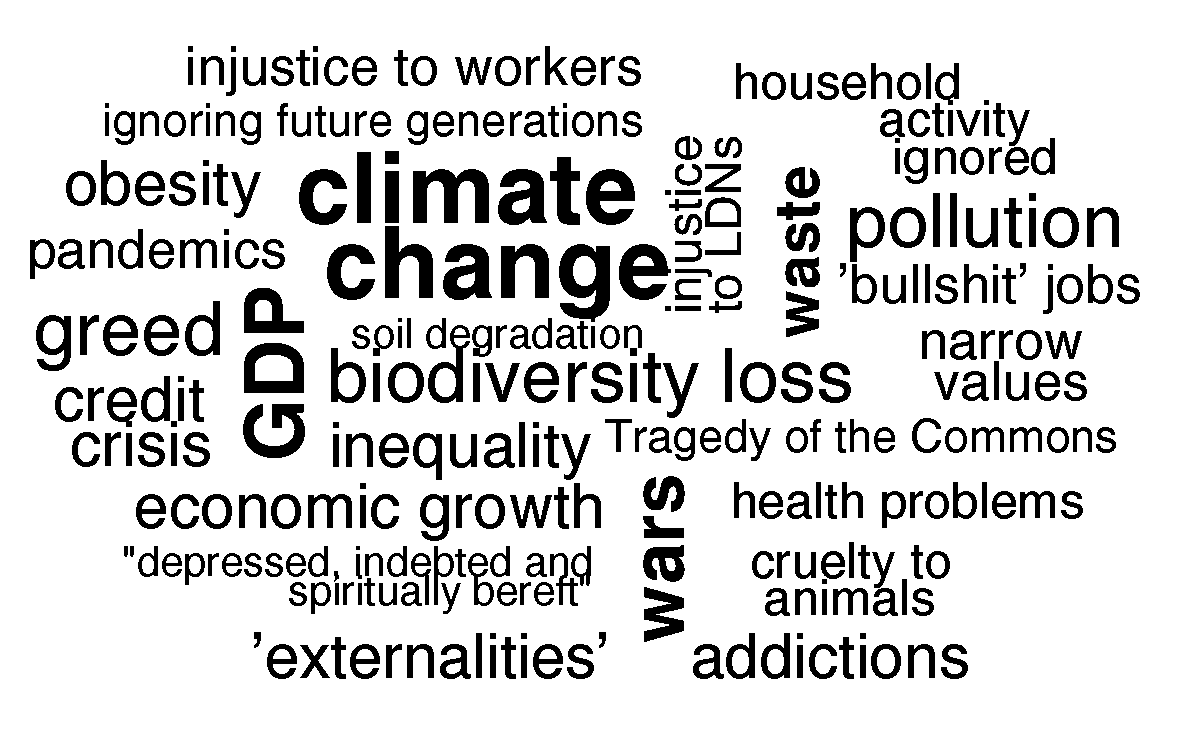
To Home Page
Executive Summary
(These pages are best viewed in a narrowish window.)
There are several 'rethinks' of economics; why do we need yet another? Lots of things seem wrong with economics ...

De-growth; Sharing Economy; Microfinance; God's Good Economy; Redeeming Economics; Freakonomics; Gift Economy; Digitalization; Relational Economics; Wellbeing economics; Value of Everything; Value(s); Wellbeing Economics; Human Development Index; Biodiversity; Economics of Arrival; Economics of Enough; Economy for the Common Good; Economy of Communion; Utopia for Realists; Poor Economics; Gross Happiness Index; Blossoming Economy; Circular Economy; Happiness Economics; Christianity and the New Spirit of Capitalism; Participatory Market Systems Development; Mission Economy; Post-Growth; Natural Order of Money; True Price Movement; Doughnut Economics; Foundational Economics; Development Economics; Civil Economy; Environmental Economics; New Environmental Economics ...
Each rethinks economics in some way. Each addresses one or two of the problems, such as environment, growth, justice or wellbeing. To each, one or two previously overlooked aspects of reality beyond the economic aspect are meaningful and give concern. So many different aspects, so many different schools of thought!
Instead of offering yet another rethink of economics, we lay a foundation for rethinking economics.
So we ask, "What aspects are there, how do they interact with the economic aspect and each other?" Can this offer a larger picture in which they might all appear? To discuss this we employ Dooyeweerd's multi-aspectual philosophy. We treat theory and practice and everyday life as of equal importance, recognising the limitations of theorization. We recognise the major contribution that religious faith might offer economics. We do not take sides but embrace both left- and right-leaning perspectives, deeming there may be valid insight in each. (These are some of the perspectives that guide our thinking.)
Consider:
Example Key takeaway: Economics as 'serving' other spheres of life, all together aimed at Multi-aspectual Overall Good, rather than being the most important.
Example Key Takeaway: Economics taking account of unpaid household and volutary work.
Example Key Takeaways: 1. 'Externalities' brought into the core of economics. 2, Understanding cultural mindset and attitude and the hidden human heart.
Example Key Takeaways: 1. GDP should subtract Harmful economic activity from Good, rather than add it. 2. A way to decide where growth and de-growth should occur.
Example Key Takeaway: Money is not a resource for satisfaction; money is an opportunity for responsibility.
Each of these is introduced and discuss in Chapters 4 to 8 in Part II. In Part I you will find an introduction, Chapter 1 setting out the what, why and how of our work, Chapter 2 overviewing some recent thinking in economics, and Chapter 3 setting out the perspectives that guide our thinking. In Paet III we apply the above ideas, Chapter 9 discussing environmental economics in some detail and Chapter 10 applying the ideas to some traditional issues in economics.
|
Especially Requiring Discussion:
Environmental Economics A Richer Understanding of Poverty and Inequality GDP: An Initial Proposal ... and many more! |
This page, "http://christianthinking.space/economics/rethink.html", is part of the Christian Thinking in Economics project, which itself is within Christian Thinking Space.
Created: 5 June 2023. Last updated: 6 June 2023 better links. 8 June 2023 r8 smy. 16 June 2023 new r4 smy, r4-mindset §. 27 June 2023 discussion box. 27 June 2023 Chapter 6. 30 June 2023 redid §4-2, Meaning of economics. 1 July 2023 new intro. 29 September 2023 Chapter 7. 26 October 2023 bold and key takeaways. 9 November 2023 added to box; rw smy 4-1; Chp Smy DIV. 10 November 2023 reformatted it all to have indents etc. 13 November 2023 kt money. 29 November 2023 5-4.4 redone. 30 November 2023 7-4.5 INW added. 15 December 2023 new section 3-2 embracing; renumbered rest. 16 December 2023 3-3.8 aspanal. 28 December 2023 r4. 25 January 2024 r6 msll. 27 January 2024 r3 rlg persp 1,2. 30 January 2024 saving. 2 February 2024 3-5.4 Rlg 3. 9 February 2024 MAOG. 17 February 2024 extra 6.2.2; renumber. 22 February 2024 errors, and rw perspectives; ch3 smy. 24 February 2024 rw most so it explains about the rethink, and no longer tries to be a home page. 26 February 2024 rw intro qns. 21 March 2024 §3-4 rw. 26 March 2024 §3-4 merged into §3-7, all renumbered, summaries altered. 10 April 2024 new intro. 22 April 2024 ch 8 headings. 24 April 2024 smy for §3-4.1. 23 May 2024 rw KeyT of r5. 1 June 2024 r4 chsmy. 4 June 2024 r4 on econ asp rw. 8 June 2024 r4 s-roam. 13 June 2024 r4 hdgs. 30 August 2024 new ch3 contents. 31 August 2024 hdg 3-3.5 change. 6 September 2024 USPs. 7 September 2024 hdgs in r6-fun. 16 September 2024 r3, spirituality. 21 September 2024 rw intro to have pix etc. 24 September 2024 new sect 3-3.2 on Scripture verses. 26 September 2024 better title: Multi-aspectual Ecx. 3 October 2024 updated r3 headings, summaries. 8 October 2024 new title: Foundation. 9 November 2024 mult rethinks. 11 November 2024 Cojanu. 13 November 2024 r5 contents. 19 December 2024 added 5-4.7 judgment. 27 January 2025 4-2.7 redef. 25 February 2025 gdp rw. 31 March 2025 ch 6 contents. 1 April 2025 ch6 smy rw. 7 May 2025 relabel. 8 May 2025 commented out usps. 16 May 2025 label. 13 June 2025 5-2.3 Human values. 7 July 2025 ch7 contents. 8 July 2025 ch3 and §3-4 smy rw. 12 July 2025 ch4 smy. 14 July 2025 new sects 4-2.5, 4-4.5, rw some headings, smys. 25 July 2025 rw and shortened intro, replacing Intro until 24 July 2025; other major rw, moved persps to our.perspectives; moved contents to contents.html; removed structure of page and site.